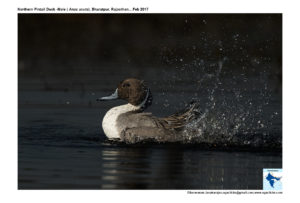Northern Pintail |

Northern Pintail Anas acuta
Etymology:
- Anas : Latin word for Duck
- Acuta : Latin word acutus -sharp-pointed
Vernacular Names: Sind: Kokarali, Drigosh, Hindi: Sand, Seenkh par Battak, Sans: Shaku hans, Pun: Sinkhpur, Bi: Dighonch, Ben: Dig hans, Bada digar, Sholoncho, Ass: Najal hanh, Neji hanh, Dighal, Mani: Meitunga, Nepal: Digunch, Guj: Singpar, Kutch: Dhruguchho, Mar: Saruchi, Talvaar badak, Ori: Suru Nanja, Nanja, Nanda, Ta: Oosival chiravi, Markalian, Te: Sudi toka batu, Mal: Vaalan eranda
Distribution in India: Wide spread winter visitor in India.
Description: Size of 51-56 cm. Male in breeding plumage has chocolate-brown nape, throat and head, contrasting with white stripe on neck-sides and largely grey-vermiculated upperparts and flanks, with foreneck, breast and central underparts white, becoming yellow-buff ventrally, black tail-coverts, brownish-grey primaries, greyish-brown wing-coverts with buff fringes to greater coverts, metallic green to bronze speculum that becomes blacker inwards and has black subterminal band and broad white trailing edge, grey underwing with darker coverts, grey scapulars and tertials with black central stripes, and two central rectrices highly elongated and slender, black with pale grey fringes; bill blue-grey with black central stripe, nail and cutting edges, legs grey and eyes brown, occasionally yellowish. The eclipse plumage is similar to that of adult female, but has heavier markings on head, elongated grey tertials, well-marked speculum and dark central tail, while simultaneously lacking buff fringes to body feathers that are characteristic of females. Female has greyish-brown head and neck, finely flecked and mottled darker, slightly paler and finely mottled neck and underparts, brownish flanks with darker crescent markings, brownish-grey upperparts with scalloped effect, grey-brown wings with pale tips to greater coverts and duller, bronze-brown speculum with broad white trailing edge; bill duller than male with less obviously dark culmen, other bare parts as male.
Habitat: It is found in shallow, usually eutrophic, freshwater marshes, small lakes and rivers, preferably with dense vegetation cover in open country, and including ephemeral wetlands. In winter, it is found also on coastal lagoons with brackish or saline waters, reservoir.
Food Habits: It eats seeds, tubers and vegetative parts of aquatic plants and sedges; in spring and summer, also aquatic invertebrates, insects, molluscs, crustaceans, amphibians and some small fish. They feed principally by upending, dabbling and head dipping in shallow water, with occasional dives.
Breeding Habits: They breed from Mar –May in North America and North and West Europe. The nest is slight hollow lined with grass, leaves and other plant matter, and down, situated on ground, normally among vegetation .Single-brooded, but females that lose their first clutch can try up to two replacement clutches. They lay a clutch of 7–9 eggs .The incubation period is 21–25 days, by female alone; chicks are precocial and tended by female till fledging which is 40–45 days after hatching.